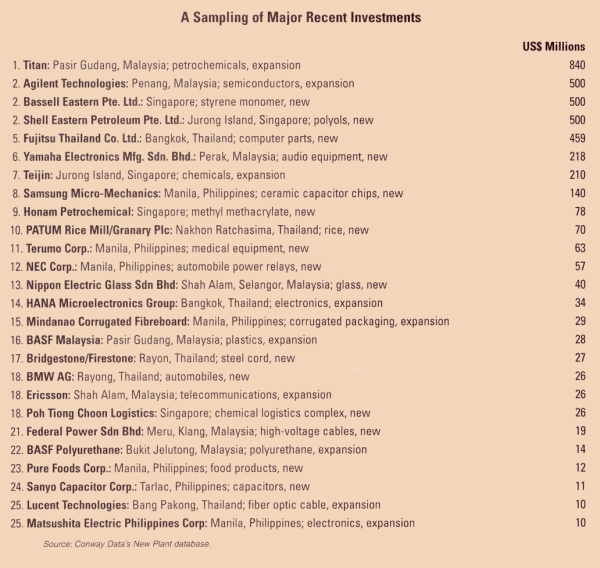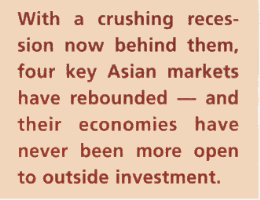 What’s upbeat, on the rise and ranges between 4 and 6.3 percent?
What’s upbeat, on the rise and ranges between 4 and 6.3 percent?
Answer: current gross domestic product forecasts for four of Southeast Asia’s biggest economies. Indeed, the 2000 economic outlook for Malaysia (where growth over 1999 is expected to hit 6.3 percent), Singapore (6 percent), Thailand (5 percent) and the Philippines (4.5 percent) is decidedly rosier than it was in 1997 and 1998, when a financial meltdown hammered much of Asia.
But even those difficult economic times had a silver lining, prompting reforms that have made business climates more inviting. In the Philippines, for instance, retailing is no longer the exclusive domain of businesses owned by Filipinos; a new law allows large foreign retailers to open stores.
“Southeast Asian societies are very open to the world,” says George Yeo, Singapore’s trade and industry minister. “Singapore is committed to making it as hassle-free as possible for businesses to set up shop.”
Perhaps the most critical hurdle for Southeast Asia to clear in its drive to attract increasing amounts of foreign investment is continuing progress toward free trade in the region. The 10-member Association of Southeast Asian Nations, or ASEAN (which includes Malaysia, the Philippines, Singapore and Thailand) is creating a free-trade area with tariffs ranging from 0 to 5 percent by 2003.
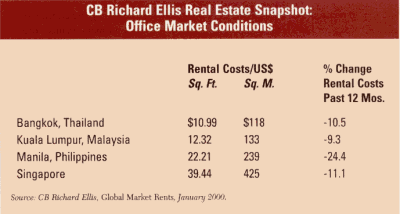 “If ASEAN fails to implement free trade, it could become a second-rate player in FDI flows into Asia,” cautions Ernest Z. Bower, president of the Washington, D.C.-based US-ASEAN Business Council (www.us-asean.org). “Big companies who invest billions of dollars will not invest in Southeast Asia in critical mass unless they see a market to move goods across borders without tariffs.”
“If ASEAN fails to implement free trade, it could become a second-rate player in FDI flows into Asia,” cautions Ernest Z. Bower, president of the Washington, D.C.-based US-ASEAN Business Council (www.us-asean.org). “Big companies who invest billions of dollars will not invest in Southeast Asia in critical mass unless they see a market to move goods across borders without tariffs.”
But Bower says the roughly 400 American companies that are members of the US-ASEAN Business Council — companies now operating in the region — are bullish on growth prospects. “They feel like the region is coming back,” he says. “We’re seeing sales return to pre-crisis levels now. The region’s gross domestic product is about US$1 trillion, and the average age of the population is near 20.”
Indeed, the region’s potential for growth “is quite enormous,” says Tan Sri Datuk Zainal Abidin Bin Sulong, chairman of the Malaysia Industrial Development Authority. “There are 530 million people in Southeast Asia.”
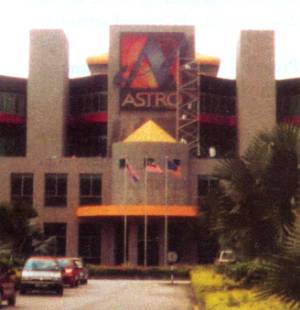 Malaysia’s High-Tech Focus
Malaysia’s High-Tech Focus
Malaysia has long been a major producer and exporter of primary commodities such as tin, rubber and palm oil. An industrialization effort launched years ago, though, has been so successful that today 82 percent of the nation’s exports are manufactured products. And much of those exports are of the high-tech ilk.
“We are No. 3 or No. 4 worldwide in semiconductors and electronic equipment,” says Sulong. “All the big companies are here — U.S., Japanese and German companies — and they are happy with our work force, its quality and productivity. With each new product, our work force absorbs the learning curve very quickly. International companies make full use of the talent of our people. In fact, Malaysians typically run the show for multinationals here.”
Disk-drives leader Seagate, for instance, announced plans last year to invest an additional $447 million in Malaysia, where it now has seven manufacturing plants and employs more than 14,000. Seagate has operated in Malaysia since 1988.
Komag, a U.S-based supplier of thin film media for computer hard-disk drives, is moving its primary production base from Silicon Valley to Malaysia. A key reason: Malaysian workers’ proven track record in handling new technologies and manufacturing processes.
Xircom, a mobile access solution networking firm, is expanding its Malaysian operations, building a $2.5 million, 55,000-sq.-ft. (5,100-sq.-m.) Worldwide Distribution Center.
Expansion-minded high-tech firms will want to keep an eye on the developing Multimedia Super Corridor, a 31-mile (50-km.) corridor some 9.3 miles (15 km.) wide extending from the center of Kuala Lumpur to Kuala Lumpur International Airport, the region’s largest international airport. The site (www.mdc.com.my) aims to create the “perfect global multimedia site,” promotional materials indicate.
“The MSC has a very bright future,” Bower says. “We’re starting to see America’s top companies get in there.”
Philippines: A Bridge
Between, East, West
You might remember from your old geography textbook that the Philippines has a lot of islands — more than 7,000, to be specific. What you might not know is that the Philippines also has a very large population (roughly 70 million), which translates into an equally sizable market for goods and services.
The Philippines is a unique place, at the crossroads of Eastern and Western business, trade and culture. “We know how to blend with both the East and West,” says Dr. Thomas G. Aquino, governor of the Philippines Board of Investments. “It makes us a good player in the global market.”
Labor is a particular strength for the Philippines. There is a large pool of computer-literate manpower, and some 30,000 to 40,000 people graduate annually from engineering schools. Filipinos are universally conversant in English, and the literacy rate is a whopping 94 percent. “From managerial to shop-level positions, Filipino manpower is increasingly being singled out to be cost-efficient and highly productive,” Aquino says.
Regulations are business-friendly. The country allows 100 percent foreign ownership of many types of activities, and complete repatriation of earnings and capital is assured. Incentives are on a par with other ASEAN countries.
Electronics and information technology companies are investing heavily. Intel Corp., Amkor Technology, Texas Instruments and other semiconductor firms, for instance, have poured more than $5 billion into the Philippines during the past three years. America Online’s customer e-mail response facility, located in the Clark Special Economic Zone, now employs 600 people who answer e-mails for AOL from all over the world on a 24-hour basis. And Anderson Consulting employs 700 Filipino programmers and computer professionals.
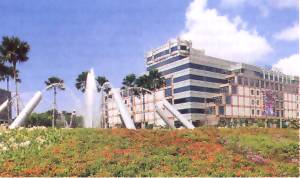 Singapore: ‘Better Managed
Singapore: ‘Better Managed
Than Any U.S. City’
Singapore’s economic recovery is strong and moving ahead, a fact underscored by the $4.6 billion in new manufacturing investment and $900 million in new service-industry investment that the country attracted in 1999.
U.S. companies played a big role in 1999’s success story, accounting for 42 percent of all fixed investment. In fact, U.S. investment was 56 percent higher than in the previous year, primarily due to several big chemicals projects. Investments from Japan, though, declined as a result of the weak Japanese economy. European firms’ investment totaled $640 million, about the same as last year.
In the pharmaceuticals sector, Schering-Plough, Aventis, Wyeth-Ayerst and Merck Sharp & Dohme all launched major new facilities. Wyeth-Ayerst’s $145 million facility will employ some 300 in the production of hormone replacement therapy products.
Recent medical devices investors include Becton Dickinson, PE Corp., Biosensors and Mallinckrodt, which relocated its regional headquarters from Hong Kong.
Singapore, it’s clear, has a lot to offer foreign investors.
“Singapore is better laid out and managed than any U.S. city,” claims Bower. “It has no garbage, no crime and perfect transportation infrastructure. Singapore and Rotterdam (Netherlands) typically compete for the title of No. 1 port in the world, and the Singapore airport is one of the world’s most efficient.”
Singapore is expensive, he says, but competitive with Tokyo and Hong Kong.
Automakers Drive
Into Thailand
Like Singapore, things are looking up in Thailand. “The level of investment is really up, because people are convinced the time has come,” says Staporn Kavitanon, secretary general of the Thailand Board of Investment.
Automakers, like General Motors Corp. (GM), dominate investment headlines. The auto giant in May opened its new $640 million assembly plant in Rayong, some 90 miles (145 km.) south of Bangkok. The plant employs 600.
Finished about 16 months behind schedule due to Asia’s economic crisis of 1997-98, the factory is expected to produce 8,000 vehicles this year and 40,000 in 2001. Some 85 percent to 90 percent of the factory’s output will be exported.
GM originally planned for a capacity of 100,000 units per year, but later scaled back its plans after the financial crisis hammered the regional auto market. Sales are now recovering, though, and Thailand’s exports of automobiles and parts soared by 80 percent last year.
GM President G. Richard Wagoner Jr. paid tribute to the plant’s work force, declaring that quality standards would allow export “to some of the most discriminating markets in the world.”
The new factory will produce the Zafira, a cross between a minivan and a more traditional sedan, which is set to be the first vehicle from Thailand’s burgeoning auto industry to be exported to Europe. It’s also set for export to Latin America, Asia and Australasia, extending the East Asian markets that most Thai production has served until now.

